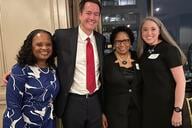You have /5 articles left.
Sign up for a free account or log in.
Communication and marketing will always be decentralized.
By that, I mean that even if your institution has a central marcom team, nothing changes the fact that your audiences in general and the individuals you’re trying to reach experience communications and marketing differently. They pay attention to messages from a multitude of messengers.
Some people read your emails avidly. Others pay attention to your Facebook posts. Still others ignore everything until their former roommate brings something to their attention. The best higher education communicators embrace this reality, know that they can’t do it alone, and ask for help.
Implied, assumed or declared authority over communications, messaging and brand can make it difficult to ask for help, but it’s usually more a question of effectiveness, not a question of competence. Welcoming others to share the load offers enormous benefit in most situations, although doing so still demands thoughtful leadership and deliberate action for a distributed communications approach to work.
When Sharing Works
Let’s say an institution is prepping for a major announcement that will, in some way, impact almost every conceivable constituency, including: prospective students, current students, faculty, staff, parents, alumni, community stakeholders and others. It could be a positive story—a major gift that will fund scholarships, a new program launch or the like. Or it could be less positive situation, like budget cuts, restructuring, or a major reputational threat. The broader the impact of a message, the more it will benefit from a distributed model. Different audiences need different levels of detail or background, and will respond better or worse to messages based on how they are delivered, where, and by whom. This is rarely a one channel, one-person job, even if the message is the same across the board.
Who Matters
Messengers often matter as much as messages. Credibility and relationships play an enormous role in effective communication. Nobody wants to hear about personnel changes from the marketing person, even if that person is, on paper, in charge of communications. In the same way, alum often want to hear from the president in times of major change, good or bad, before they read about it in the news. Faculty might prefer to hear from their colleagues, whose take on the situation will feel (and be) more authentic from someone in the same position. Welcome people and groups outside of the normal hierarchy to help with communications and develop a core group of credible voices that can best speak to the right audiences at the right level, in the right way.
Getting Everyone on the Same Page
Critical to the success of shared communications is avoiding too many overly-nuanced versions of the same basic facts. Alignment among messages and messengers is a must. Get everyone in the room and start with the facts in an honest, direct, unspun discussion. Then listen to how different people respond. What questions emerge? What voices are missing? What issues are unresolved? How do different people interpret different facts? Use this insight to develop a short (three to five) list of key messages that cut across audiences, remain true to the facts without too much subtlety. Start with the internal message—nailing this will make the external messaging much easier, particularly since those people closest to the issue and institution will, by default, become messengers.
Practice Makes Sense
With messages defined and messengers on board, the best next step — if time allows — is to practice. Giving people, especially those not used to such a role, the chance to answer questions out loud, in person, with others generates enormous confidence and will very quickly reveal areas for improving clarity and language. Practice answering different questions from different people in different contexts. Imagine a supervisor answering questions from a staff member, a national reporter interrogating a president, a skeptical student questioning operations staff, or an alum looking for ways to help. Rely on the group to help refine answers and messages for different audiences.
Letting go of control can be terrifying, but it’s also necessary. Even the most talented communicators cannot speak credibly to all audiences about all things all the time. That’s the work of a community. True communications leadership is developing a healthy communications ecosystem that builds on the strength of many voices that share a common message.
Tim Jones in the Chief Communications and Integrated Marketing Officer at Beloit College in Wisconsin.




